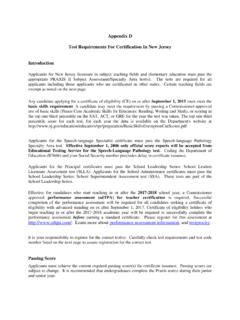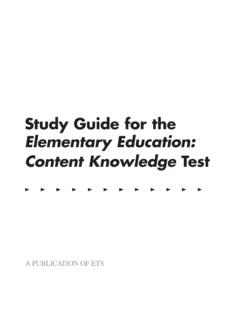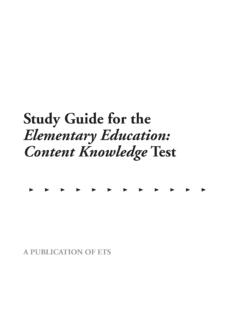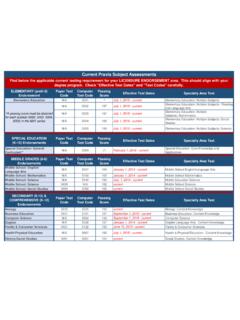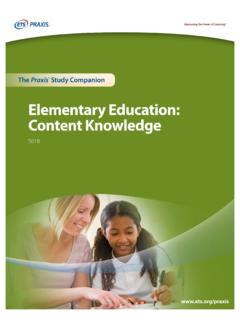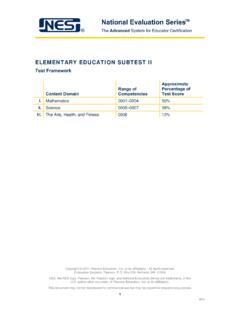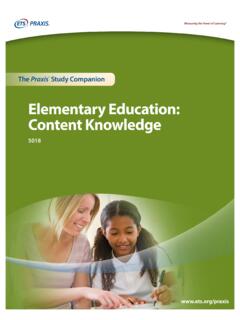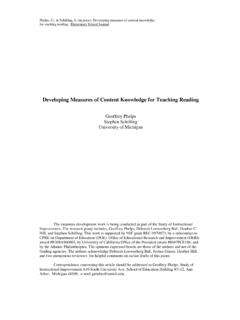Transcription of 103 Elementary Education - DePaul University
1 103 Elementary EducationMI-SG-FLD103-01 Effective after October 1, 2013 TABLE OF CONTENTS PART 1: General Information About the MTTC Program and Test Preparation OVERVIEW OF THE TESTING 1-1 Contact Information Test Development Process Characteristics of the Tests Test Administration Paper-Based Testing Computer-Based Testing Receiving Your Scores Examinee Score Reports HOW TO PREPARE FOR THE 1-4 Plan Your Course of Study THE DAY OF THE TEST: HELPFUL 1-5 Preparing for the Test Administration Test-Taking Tips Test Directions PART 2: Test Objectives and Sample Test Questions 2-1 TEST 2-3 SAMPLE MULTIPLE-CHOICE TEST 2-19 ANSWER KEY FOR THE SAMPLE MULTIPLE-CHOICE TEST 2-33 Michigan Test for Teacher Certification Study Guide i ii Michigan Test for Teacher Certification Study Guide Readers should be advised that this study guide, including many of the excerpts used herein, is protected by federal copyright law.
2 Copyright 2013 Pearson Education , Inc. or its affiliate(s). All rights reserved. Evaluation Systems, Pearson, Box 226, Amherst, MA 01004 PART 1: General Information About the MTTC Program and Test Preparation The first section of the study guide is available in a separate PDF file. Click the link below to view or print this section. General Information About the MTTC Program and Test Preparation Michigan Test for Teacher Certification Study Guide iii Michigan Test for Teacher Certification Study Guide 2-1 PART 2: Test Objectives and Sample Test Questions INTRODUCTION The Elementary Education test (103) consists of 150 multiple-choice items. This section includes a list of the test objectives, immediately followed by sample test questions and an answer key for the field covered by this study guide.
3 Test Objectives As noted, the test objectives are broad, conceptual statements that reflect the knowledge , skills, and understanding an entry-level teacher needs in order to teach effectively in a Michigan classroom. Each field's list of test objectives represents the only source of information about what a specific test will cover and, therefore, should be studied carefully. The test objectives are organized into groups known as "subareas." These subareas define the major content areas of the test. You will find a list of subareas at the beginning of the test objective list. The percentages shown in the list of subareas indicate the approximate weighting of the subareas on the test. Sample Multiple-Choice Test Questions The sample multiple-choice test questions included in this section are designed to give the test-taker an introduction to the nature of the test questions included on the MTTC test for each field.
4 The sample test questions represent the various types of test questions you may expect to see on an actual test; however, they are not designed to provide diagnostic information to help you identify specific areas of individual strengths and weaknesses or predict your performance on the test as a whole. Use the answer key that follows the sample test questions to check your answers. To help you identify which test objective is being assessed, the objective statement to which the question corresponds is listed in the answer key. When you are finished with the sample test questions, you may wish to go back and review the entire list of test objectives and descriptive statements once again. Elementary Education Michigan Test for Teacher Certification Study Guide 2-3 TEST OBJECTIVES Subarea Approximate Percentageof Questions on Test English Language Arts and World Languages Social Studies Visual and Performing Arts Mathematics Science Health Education and Physical Education 24% 16% 10% 22% 18% 10% I.
5 ENGLISH LANGUAGE ARTS AND WORLD LANGUAGES 001 Understand the major concepts, principles, and instructional practices in the acquisition and learning of languages to create opportunities for communication in a multilingual global society. Includes: knowledge of language as a dynamic system, and strategies for helping students acquire and use language in listening, speaking, reading, and writing for social and academic purposes basic concepts related to the phonological, morphological, semantic, syntactic, and pragmatic structures of English as applied to listening, speaking, reading, and writing recognition of the integrated nature of reading, writing, listening, speaking, viewing, and visually representing, and the importance of integrating the use of these modes of communication in all content areas concepts and processes related to first- and second-language acquisition, factors ( , physical, social, cognitive, and emotional differences; developmental.)
6 Cultural; environmental) that can affect language acquisition and literacy development, and the implications of these processes and factors for instruction knowledge of the relationships between language and culture; the interconnections among cultural perspectives, practices, and products; and strategies for integrating language and culture in instruction to encourage students to make cultural connections and comparisons knowledge of effective strategies and resources for creating a supportive, respectful classroom environment that provides opportunities for meaningful interaction and negotiation of meaning, which facilitate language acquisition and student achievement Elementary Education 2-4 Michigan Test for Teacher Certification Study Guide 002 Understand the foundations of emergent literacy, including the development of phonological and phonemic awareness skills.
7 Includes: the role of oral language development in emergent literacy, and strategies for promoting oral language development to enhance emergent literacy knowledge of phonological awareness, including phonemic awareness, and its significance in emergent literacy development; and research-based strategies for developing phonological and phonemic awareness skills knowledge of strategies for promoting development of concepts of print, letter recognition, and letter formation knowledge of strategies for promoting understanding of the alphabetic principle, including the use of reading and writing activities for teaching sound-symbol correspondence knowledge of processes by which emergent readers construct meaning and factors that influence their construction of meaning 003 Understand the development of accurate, automatic word recognition, spelling, and fluency.
8 Includes: characteristics of and relationships between stages of reading development and writing development the development of phonics knowledge and skills at beginning stages of reading development to promote accurate, automatic decoding and accurate spelling of regular single-syllable words the use of grade-level-appropriate sight words, common inflectional morphemes, and orthographic patterns and guidelines in combination with differentiated phonics instruction to promote accurate, automatic word recognition and spelling the use of syllable patterns and structural analysis to promote accurate, automatic decoding and spelling of multisyllable words at more advanced stages of literacy development knowledge of indicators of fluency ( , accuracy, rate, and prosody), factors that can disrupt fluency, the role of fluency in reading comprehension, and strategies for promoting fluency at various stages of reading development knowledge of developmentally appropriate materials and effective, research-based reading and writing activities to promote word recognition, spelling, and fluency at various stages of literacy development.
9 And appropriate methods for assessing word recognition, spelling, and fluency Elementary Education Michigan Test for Teacher Certification Study Guide 2-5 004 Understand the development of vocabulary and reading comprehension. Includes: the relationship between oral and written vocabulary development and reading comprehension, elements of effective vocabulary instruction ( , explicitly teaching words, providing meaningful opportunities to use new vocabulary), and strategies for selecting vocabulary for instruction knowledge of research-based strategies for explicit instruction of words and their meanings, independent strategies for building vocabulary, and independent strategies for verifying the meanings and pronunciations of unfamiliar words or words with multiple meanings ( , structural analysis, reference materials, semantic and syntactic cues) application of knowledge of different levels of reading comprehension ( , literal, inferential, evaluative, critical)
10 And factors that affect reading comprehension and a reader's construction of meaning ( , automaticity of word recognition, vocabulary knowledge , background knowledge , linguistic and organizational complexity of the text, context of the written situation) knowledge of effective comprehension strategies for different texts and purposes for reading knowledge of developmentally appropriate materials and effective, research-based oral language, reading, and writing activities to promote the development of vocabulary and comprehension at different stages of reading development; and appropriate methods for assessing vocabulary and reading comprehension 005 Understand the characteristics of narrative and expository texts in written, oral, performance, and media forms.

